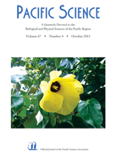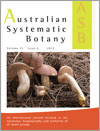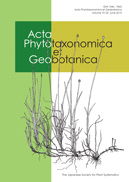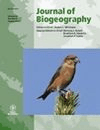
PROCEEDINGS OF THE LINNEAN SOCIETY OF NEW SOUTH WALES
Scope & Guideline
Illuminating the Path of Ecological Knowledge and Discovery
Introduction
Aims and Scopes
- Paleontological Research:
The journal frequently publishes studies on fossils and ancient life, focusing particularly on Australian geological formations. This includes the description of new species and the exploration of evolutionary history. - Ecological and Environmental Studies:
Research on vegetation patterns, fire ecology, and the impact of climate change on ecosystems is a core focus, reflecting the journal's commitment to understanding and preserving biodiversity. - Biogeography and Plant Studies:
Many articles investigate plant biogeography and ecology, contributing to knowledge about flora distribution and the factors that influence plant communities in New South Wales and beyond. - Cultural and Historical Perspectives:
The inclusion of studies that examine the intersection of natural history with cultural and historical narratives enriches the journal’s scope, providing context for environmental changes and human impact. - Conservation and Management:
The journal addresses issues related to conservation strategies and the management of natural resources, highlighting the importance of sustainable practices in preserving biodiversity.
Trending and Emerging
- Impact of Climate Change on Ecosystems:
Recent studies increasingly focus on the effects of climate change, particularly in relation to fire ecology and vegetation patterns, underscoring the urgency of understanding these impacts on local biodiversity. - Fungal Diversity and Ecology:
Research on fungi, particularly club and coral fungi, is emerging as a significant theme, highlighting the ecological roles these organisms play and their responses to environmental changes. - Fire Ecology and Resilience Studies:
The increasing focus on the impact of bushfires, particularly following the 2019-20 mega-fires, indicates a growing interest in understanding fire dynamics and resilience in Australian ecosystems. - Interdisciplinary Approaches to Natural History:
There is a trend towards integrating various disciplines, such as combining ecology with geomorphology and climate studies, to provide a more holistic understanding of environmental changes. - Endemic Species and Conservation Strategies:
Research on endemic species, especially in response to environmental changes, is gaining traction, reflecting a broader concern for conservation and the need to develop effective management strategies.
Declining or Waning
- Historical Biological Studies:
Research focused on historical biological figures or events, such as the detailed reports on past expeditions or historical departmental studies, has seen a decline, possibly as the field shifts towards more contemporary ecological issues. - In-depth Taxonomic Studies of Lesser-known Species:
Although taxonomic studies remain important, there seems to be a waning interest in the extensive taxonomy of less prominent species, as the journal increasingly prioritizes ecological and conservation-related articles. - Reports on Non-native Species:
There has been a noticeable reduction in publications addressing non-native species and their impacts, which may indicate a shift towards a more localized focus on native species and ecosystems.
Similar Journals

NEW ZEALAND JOURNAL OF BOTANY
Cultivating Insights into New Zealand's Unique FloraThe New Zealand Journal of Botany, published by the esteemed Taylor & Francis Ltd, serves as a pivotal platform for disseminating significant research in the fields of Ecology, Evolution, Behavior and Systematics, as well as Plant Science. With a rich history dating back to 1963 and an impressive convergence extending to 2024, this journal has established itself as an essential resource for researchers and professionals dedicated to understanding the complexities of plant life and ecological systems in New Zealand and beyond. The journal is currently categorized in the Q3 quartile for both relevant disciplines as of 2023, reflecting its balanced influence within the global academic community. Although not an open access journal, it retains a significant impact factor, evidenced by its Scopus rankings, which place it within the top half of its categories. This makes it an invaluable tool for students, researchers, and academics aiming to engage with robust, peer-reviewed scientific findings and contribute to the evolving discourse surrounding botany and ecological research.

NORDIC JOURNAL OF BOTANY
Exploring Botanical Frontiers with Innovative ResearchNORDIC JOURNAL OF BOTANY, published by WILEY, is a distinguished journal that serves as a vital platform for the dissemination of innovative research in the fields of Plant Science and Ecology, Evolution, Behavior and Systematics. With an ISSN of 0107-055X and E-ISSN 1756-1051, this journal has been a crucial part of the academic landscape since its inception in 1981, continuing to contribute significantly to the literature up to 2024. NORDIC JOURNAL OF BOTANY holds a commendable Q2 ranking in Plant Science and Q3 in Ecology, which underscores its impact and relevance in the scientific community. Despite the absence of Open Access options, the journal offers robust access features that ensure researchers and readers can easily engage with its meticulously curated content. Aimed at both seasoned professionals and emerging scholars, the journal not only publishes high-quality articles but also fosters collaboration and knowledge exchange across various related disciplines, thereby solidifying its role as a cornerstone in botanical and ecological research.

PACIFIC SCIENCE
Exploring the Depths of Pacific KnowledgePACIFIC SCIENCE is a prestigious multidisciplinary journal published by University of Hawaii Press, dedicated to advancing knowledge across diverse fields of study related to the Pacific region. With a robust ISSN of 0030-8870 and an E-ISSN of 1534-6188, this journal serves as a vital platform for researchers, professionals, and students to disseminate and access influential research findings that contribute to the understanding of ecological, cultural, and social dynamics in the Pacific. The journal has steadily maintained its relevance since its inception in 1947 and features a commendable Scopus Rank of #74 out of 171 in the multidisciplinarity category, placing it in the 57th percentile of its field, and is recognized as having a Q2 quartile ranking in 2023. Although lacking open access options, PACIFIC SCIENCE offers in-depth analysis and scholarly discourse, effectively bridging various disciplines to foster collaboration and innovation. With its commitment to high-quality research and its significant impact on Pacific studies, the journal continues to play an important role in informing policy, conservation efforts, and community engagement within this vital region.

Revista de Sociedad Gaditana de Historia Natural
Exploring the Rich Tapestry of Natural History in CádizRevista de Sociedad Gaditana de Historia Natural, published by the SOC GADITANA HISTORIA NATURAL, stands as a pivotal journal in the realm of natural history and environmental sciences. With the ISSN 1577-2578 and E-ISSN 2340-5759, this publication seeks to advance the understanding of biodiversity and ecosystems, particularly within the biodiverse regions of Cádiz, Spain. The journal fosters an open dialogue among researchers, professionals, and students, providing a platform for the dissemination of empirical findings, reviews, and theoretical discussions related to natural history. Although it operates under a non-open-access model, it is anticipated that the journal will play a crucial role in enhancing environmental awareness and promoting conservation efforts through high-quality scholarly contributions. The importance of documenting and understanding the intricate relationships within our ecosystems cannot be overstated, making this journal a valuable resource for anyone passionate about the natural world.

AUSTRALIAN SYSTEMATIC BOTANY
Charting the Future of Australian Plant ResearchAustralian Systematic Botany is a prestigious academic journal dedicated to the field of plant science, published by CSIRO PUBLISHING. Established in 1988, this journal has become a vital resource for researchers, professionals, and students focusing on the systematic study of Australian flora. With an impressive track record and convergence extending to 2024, it operates in the Q3 category for Ecology, Evolution, Behavior and Systematics and Q2 for Plant Science as of 2023. The journal holds significant value in the academic community, given its Scopus ranking, which places it in the 61st and 59th percentiles within its respective categories. Although it follows a subscription-based model, the journal remains committed to advancing knowledge in systematic botany, offering critical insights that shape the future of ecological and biological research both in Australia and globally.

Neotropical Biology and Conservation
Fostering Dialogue for a Greener TomorrowNeotropical Biology and Conservation, published by Pensoft Publishers, serves as a pivotal platform for researchers and professionals dedicated to the understanding and preservation of biodiversity in the Neotropical region. This Open Access journal, operational since 2006 and based in Brazil, invites contributions that delve into the complexities of ecology, evolution, and conservation strategies pertinent to the diverse ecosystems of South and Central America. With a commendable 2023 impact factor reflected in its Q3 rankings across multiple categories including Animal Science, Ecology, and Plant Science, it stands as a valuable resource for academics seeking to publish innovative findings and foster dialogue in these critical areas of study. The journal's commitment to open access ensures that knowledge is readily available to anyone interested in advancing the field of neotropical biology and conservation. Join the global conversation and contribute to the vital work of preserving our planet’s rich biological heritage through rigorous research published in this esteemed journal.

Bulletin de la Societe Linneenne de Lyon
Championing Original Research in Natural SciencesBulletin de la Societe Linneenne de Lyon is a distinguished journal in the field of natural sciences, published by Société Linneenne de Lyon, a renowned institution in the heart of France. This journal, bearing the ISSN 2554-5280, serves as a crucial platform for the dissemination of high-quality research articles, reviews, and discussions that focus on the diversity of life and its conservation, reflecting the foundational principles established by Carl Linnaeus. Although it operates under a traditional access model, the bulletin significantly contributes to the advancement of botany, zoology, and ecology by providing a forum for original research that often garners attention from scholars and practitioners alike. With a commitment to fostering collaboration and dialogue among researchers, this journal is positioned as a vital resource for anyone dedicated to understanding the complexities of biological sciences and systems. The impact of its publications is amplified by its ties to a prominent academic community, making it an essential read for professionals, researchers, and students eager to stay informed on the latest developments in their fields.

Acta Phytotaxonomica et Geobotanica
Advancing Plant Science and EcologyActa Phytotaxonomica et Geobotanica, published by the Japanese Society for Plant Systematics at the University of Tokyo, serves as a vital platform for advancing research in the fields of ecology, plant science, and biodiversity. With an ISSN of 1346-7565 and an E-ISSN of 2189-7042, this journal not only provides a comprehensive evaluation of current topics within these categories but also addresses the intricate connections between plant systems and their ecological environments. Although currently not open access, the journal is essential for researchers aiming to publish cutting-edge findings, contributing significantly to its classification within the Q3 quartile across multiple disciplines, including Ecology and Plant Science. With an ambitious focus on enhancing the understanding of plant taxonomy and geography through a convergence of research periods from 2014 to 2024, Acta Phytotaxonomica et Geobotanica plays a pivotal role in fostering academic discourse and innovation in plant systematics. Its geographical foundation in Japan enriches the journal's unique perspective on regional flora, making it an indispensable resource for students, researchers, and professionals in the field.

BRITTONIA
Fostering Knowledge in Botany and Environmental InteractionsBRITTONIA, published by Springer, stands as a reputable journal dedicated to advancing the fields of botany and plant sciences. With a storied history dating back to 1931, this journal has evolved to embrace contemporary research spanning various aspects of plant biology, ecology, and systematics. Focusing on a comprehensive analysis of both ecological interactions and plant systematics, BRITTONIA plays a crucial role in disseminating knowledge among researchers and professionals committed to understanding plant life and its environmental contexts. Despite its open access status being currently unavailable, the journal ensures wide accessibility through institutional subscriptions. In the latest rankings, it proudly holds a Q2 category in Plant Science and a Q3 category in Ecology, Evolution, Behavior, and Systematics, indicating its growing influence and academic rigor. Researchers and students alike will find BRITTONIA an essential resource for the latest findings and discussions in plant sciences.

JOURNAL OF BIOGEOGRAPHY
Driving Insights into Ecological Frameworks and InteractionsJOURNAL OF BIOGEOGRAPHY, published by Wiley, stands as a premier multidisciplinary platform for the publication of high-quality research in the fields of biogeography and ecology. With an impressive Q1 ranking in both Ecology and Ecology, Evolution, Behavior and Systematics categories for 2023, this journal is recognized for its significant contribution to understanding ecological patterns and processes across geographic spaces. The journal, which has been in circulation since 1948 with a continuous production from 1979 to 2024, features rigorously peer-reviewed articles, critical reviews, and essential data that illuminate the dynamic interactions between organisms and their environments. While this journal does not currently offer open access options, it remains a valuable resource for researchers, professionals, and students seeking to explore the latest discoveries and theoretical advances in biogeography. With impressive Scopus rankings, including a 73rd position out of 721 in Agricultural and Biological Sciences and a 53rd position out of 461 in Environmental Science, the JOURNAL OF BIOGEOGRAPHY is indispensable for those aiming to advance their understanding of ecological frameworks and biodiversity conservation.